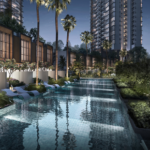Singapore residents can expect to see greater diversity within the functions and designs of future neighbourhoods. At the aptly titled exhibition “Space for our Dreams”, the Urban Redevelopment Authority (URA) recently unveiled its latest plans for residential development over the next 50 years on June 6 2022.
The decennial showcase illustrated how the URA and relevant authorities are planning to transform spaces to incorporate nature, heritage and new home types into residential neighbourhoods. These plans were drafted to make affordable housing more inclusive and accessible to Singapore’s transforming demographic with ever-changing housing needs.
Housing needs that future projects aim to address
Even assuming that the local population does not increase in absolute numbers, more housing units will be required to accommodate the singles who are moving out on their own, as well as the increasing number of small nuclear families.
Just last year, the local Department of Statistics released a report stating that the proportion of singles had increased across all age and gender brackets, most significantly amongst women aged between 25 to 29, who experienced a spike from 54% in 2010 to 69% in 2020.

Similarly, Census 2020 found that the percentage of one-person and two-person households were 16% and 22.6% respectively, with the average household size falling from 3.5 persons over a decade ago to 3.2.
The problem goes beyond space as well. Future homes have to accommodate modern lifestyles and habits to stay relevant and habitable. These include facilitating the movement of the elderly, enabling hybrid or remote work, smoothening the flow of goods and packages from e-commerce, the incorporation of smart technology as well as rising threats that will be accompanied by climate change.
Flexible flats
Open floor plan homes will grant owners the freedom to configure spaces according to their needs, rather than be confined to the restrictions of fixed layouts. Sample layouts by HDB feature customisable living and dining areas, which can be expanded or contracted to make way for more or less bedrooms depending on the specific makeup of the family.


Senior-friendly homes with assisted living facilities
With 872,000 people aged 65 and above as of 2021, a number that is expected to reach 3.09 million by 2050, homes catering to the needs of senior citizens will become an increasingly pressing necessity. Two-room flexi flats with space for live-in caregivers will continue to be rolled out.
HDB is also collaborating with the private sector to build Community Care Apartments complete with 24-hour emergency response systems and frequent health checks designed to empower the elderly for independent living. At present, public assisted living developments can be found at the Harmony Village @ Bukit Batok, supported by a hawker centre, community garden, mall and polyclinic.
Repurposing heritage sites and natural landmarks for housing
Underused and undeveloped land plots will be repurposed for residential use to increase the total capacity of the local housing market. For example, brownfield sites with structures that are less relevant to the modern economy, or with industrial buildings that can be moved to less central locations will be demolished to make way for new developments.
For example, the relocation of Paya Lebar Air Base scheduled from 2030 will free up 800 ha of land, the equivalent of five Toa Payoh towns. Additionally, it will also remove height restrictions on surrounding neighbourhoods, allowing for a significant increase in housing units in Eastern Singapore.
Dive Deeper: A Guide: Paya Lebar Airbase Redevelopment Plans – Part 1 & Part 2
History and culture buffs need not fret, as these new residentials will have distinctive emblems of the past incorporated into the neighbourhood. The blueprint of the new Farrer Park is a prime example of this, with the historic sporting ground of Farrer Park Boxing Gym being incorporated into a new multi-purpose sporting building. Similarly, the aforementioned Paya Lebar Air Base will have its iconic 3.8km runway converted into an inclined running track complete with facilities on the sides.
Expansion into undeveloped greenfield sites will supplement the conversion of old developments into residential spaces. However, since greenfield development will create a lasting negative impact on local ecosystems, authorities will exercise more caution before proceeding with such development plans.
New housing estates can be expected in the likes of Tengah, Jurong Lake District, Greater Southern Waterfront, and more.
Bringing jobs, alternative transport and public transport to neighbourhoods around the city
New MRT lines such as the Cross Island Line (CRL) and the Thomson-East Coast Line (TEL), expected to be completed in 2030 and 2025 respectively, will allow residents in neighbourhoods all over the island to shave significant time off their travel journeys.
Chief example of this is the transformation of Ang Mo Kio, which will link residents to places such as Bright Hill and Hougang within just 2-3 stations. The town will also feature an extended 16km cycling track, allowing school children and residents to get around the neighbourhood in an environmentally friendly manner.

Plans to build public housing at the residential estates of Bayshore and Upper Changi MRT station will also bring people closer to jobs in the aviation industry, for example. Bayshore, which happens to be near East Coast Park, will see a mixture of private and public housing units built. Public housing and accompanying amenities will be injected into the private estate neighbourhood of Simei. The mixture of developments is aimed to encourage intermingling of communities in public and private housing estates while also providing more options for people who are looking to settle in these areas.
Flexible recreational spaces with multiple uses
To make full use of Singapore’s limited land, plans are also underway to incorporate multiple uses into buildings and facilities to let them serve various communities throughout the day. A good example of this feature is the Dual-Use Scheme of over 300 school sports facilities, which has been providing training grounds for school sports teams on the weekdays and recreational sports spaces for the community on weekends.
Other underutilised spaces such as the rooftops of multi-storey car parks, void decks and vacant state land that are not required for immediate development are also being considered for communal activities. Residents can already participate in community gardening on selected rooftops, as well as reserve void deck spaces for specific social or recreational functions. The most recent incorporation of Marymount Community Centre into the campus of Eunoia Junior College has taken multifunctional spaces to the next level by allowing recents to access school facilities and interact with students.

No stone will be left unturned to ensure that every square foot of space is utilised, with the Land Transport Authority and accompanying stakeholders running pilot projects to redesign Yishun MRT and Tampines MRT into community hubs complete with commercial services.
Residents are welcome to exercise their creativity in how spaces can be used, too. The Lively Places Programme provides funding for ground-up initiatives that seek to incorporate unique designs, safe-distancing features, greenery, recreation and more. That’s how The Pets Park @ Segar Gardens in Bukit Panjang, a space for pets and pet owners to interact with one another, came about.
Access to healthy living for all ages
Having easy access to healthcare services and a community are essential resources that not only help to preserve lives, but enable populations to thrive. To promote healthy living within neighbourhoods, HDB, the National University Health System Residents and the National University of Singapore recently collaborated to pilot the Health District @ Queenstown. Meant to be a testbed for science-backed developments, the project saw roof gardens incorporated with staircases, fitness facilities and jogging tracks all designed to keep residents fit while providing them with clean air and vibrant views.

Programmes to rejuvenate ageing towns
Older neighbourhoods will not be left behind in this push towards the future. Various programmes are already in place to give old towns a fresh coat of paint.
For example, the Neighbourhood Renewal Programme introduced in August 2007 lets residents request for block- and precinct-level improvements such as sports parks, fitness stations and drop-off porches to their neighbourhood. Blocks built before the year 1995 that have not undergone the Main Upgrading Programme, Interim Upgrading Programme (IUP) or IUP Plus are eligible for the programme. Residents may direct their upgrade requests to their respective Town Councils.
Other ongoing programmes such Selective En bloc Redevelopment Scheme and Voluntary Early Redevelopment Scheme will give residents the opportunity to get a renewed lease on their HDB flats while also freeing up land on older HDB towns to make way for developments that have been mentioned throughout this article.
The “Space of our Dreams” exhibition will be open for public viewing at The URA Centre from 6 June 2022 until August 4 2022 every Monday to Saturday. Guided tours are available on Tuesdays, Thursdays and alternate Saturdays. Displays are also accompanied by interactive voiceovers in Singapore’s four official languages.
Looking for an HDB or private property?

Let Ohmyhome’s smart data-matching technology MATCH you with the right home, according to your specific needs. Submit your preferences to us and our algorithm will filter all our available listings based on those, and we’ll WhatsApp them to you once we find a match.
We’ll also send you relevant content that you can use for your research and inform your home buying decision, so you no longer have to spend hours searching online for the information that you need. Because at Ohmyhome, we’re always by your side, always on your side.
You can also call us at 6886 9009 to secure an appointment with any of our Super Agents or message us in the chatbox at the bottom, right-hand corner of the screen. You can also WhatsApp us at 9755 9283!



































































